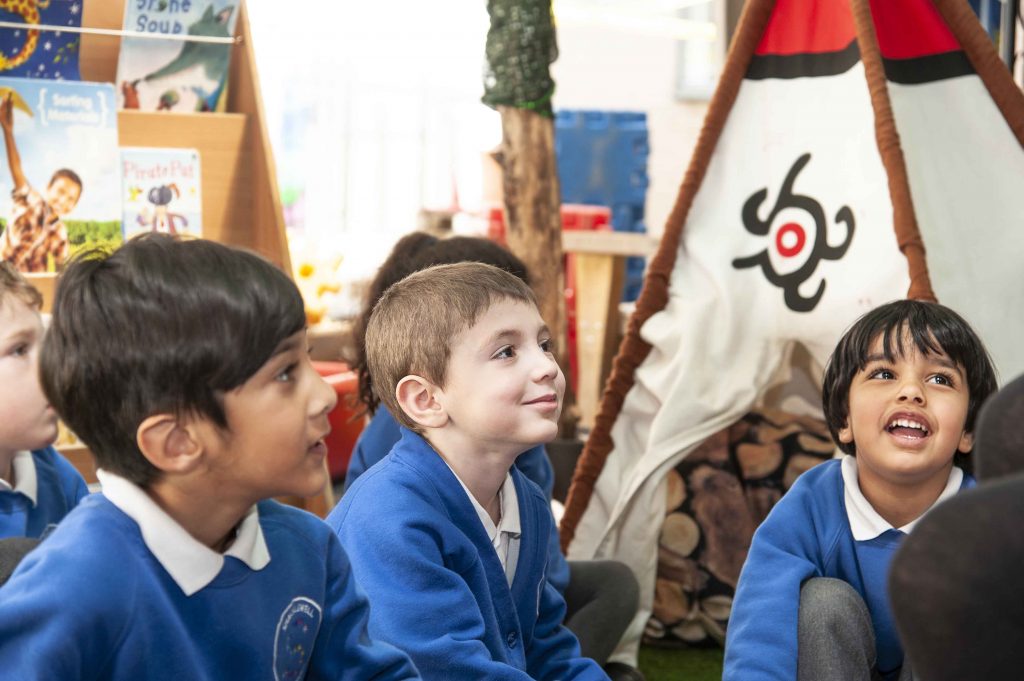Take two eight year-olds, Jack and Daisy: same age, but years apart in reading ability.
Jack loves reading. He’s always got a book with him and reads it under the table when he thinks his teacher isn’t looking. By the end of a story he’s reading at over 200 words a minute, he writes prolifically and even gets his plays acted out in assembly.
Daisy hates reading. She leaves her book bag in the cloakroom and her writing is, well, short.
Daisy skips over words she can’t recognise while Jack works them out. Jack gets so absorbed in his reading that he cuts out everything else. Daisy can’t cut through the distractions and finds it hard to pay attention. Her anxiety about reading makes her freeze and she stares at the pictures instead.
Jack has the reading habit for life. Daisy’s struggle will continue to obstruct her progress at school and critically undermine her confidence. Her fingernails are already bitten to the quick.
WE AREN’T BORN TO READ
You all know similar children. It would be easy to put their reading progress down to intellectual ability – and think that the problem must be Daisy’s brain. However, there’s no gene for reading, in the same way as there’s no gene for piano playing or tap dancing. Reading was invented only a few thousand years ago and, although our brains are hardwired to see and to hear, they are not hardwired to read. A brain has to change radically for it to become a reading brain, creating brand new structures and circuits. Some brains take longer than others, in the same way that others take longer to learn to play the piano or tap dance.
In order to learn to read, each child has to start from scratch, building new circuits one by one. Synapses need to fire one neuron to the next, over and over to create templates in the brain. Get the wiring wrong and the brain short circuits, in the same way that placing your hands incorrectly on the keys will hamper your chances of playing the piano well.
Jeanette Winterson says, ‘Teach a child to read and keep that child reading and you will change everything.’ So how do you do it?
Let’s take a look at how Jack came to be a reader. His granny taught him the alphabet sounds when he was two and a half and they made up words with magnetic letters. She helped him sound out words in short stories that build up the letter-sounds carefully, but soon he started working out the words in the stories she read to him. They’d read the same story over and over again, and gradually Jack started reading, bit by bit. Granny carried on reading with him – it was their special thing. It didn’t seem a big deal for Jack to learn to read and by the time he arrived at school, reading had become part of him.
Maryanne Wolf, in ‘Proust and the Squid’, explains what goes on in Jack’s brain now that he’s a fluent reader. Here’s a potted version.
When he picks up a book his brain leaps to attention – he cuts out whatever is going on around him. He loves the book so much he wants to pay attention.
His eyes sweep across the page and, without a single moment of conscious awareness, he associates specific letters with specific sounds and specific letter patterns with specific words. His eyes make small movements called ‘saccades’ as he takes in about 15 letters at once, giving him a preview of what’s about to come a millisecond later. As he gathers all this information it fast-forwards to the area of his brain that handles language.
In the next milliseconds, he draws upon his knowledge of real and imagined worlds, and fills the gaps the writer – deliberately – leaves from the page. Jack takes in the meaning and implication of every word and selects the most appropriate, given the context. He generates his own inferences and hypotheses, constantly predicting what might happen next. If he forgets what’s just happened then his eyes flit back to pick up the information he needs.
He knows that reading is like a puzzle; you need to figure things out.
THE TIPPING POINT
Jack has made an emotional engagement with reading, one that Maryanne Wolf describes as “the tipping point between leaping into the reading life or remaining in a childhood bog where reading is endured only as a means to other ends”. Jack’s limbic system has been activated. He’s in there with his hero – feeling what he’s feeling – anxious for him, desperate that something awful could happen. His feelings drive him forward…deeper into the story. Those black marks on white paper evoke an entire universe of meaning for Jack.
Like Jack, Daisy is loved and well-cared for, but her sleepless baby brother means that her parents are exhausted after work. They have always read to her every night but they didn’t teach Daisy to read before she started school. In Reception she didn’t pick up the letter-sounds as quickly as other children and got left behind – maybe she was tired too. When the letters came out the bag she froze. She looked at her shoes, picked bits of fluff from the carpet and thought about home. She knew quite a few letters by the end of the year but hadn’t picked up on how to blend them together.
A TALE OF TWO BRAINS
Jack’s brain is a trained brain. The more he reads, the more he knows. He’s put in the miles – the hours of reading at home. By the age of eight he’s already put in over 500 hours – that’s over 6 million words. He scoops up new words as he reads. In just one short story by Michael Morpurgo he scoops up 10 more: furrowing, lode, adit, flailing, spriggan, cowrie, kittiwakes, scoured, affinity, quoite.
Daisy’s brain hasn’t been trained. She finds it hard to pay attention when the teacher writes things on the board. She’s not put in the miles – only reads a few pages, now and again at home. She’s one of the children who read about 8000 words a year – only 10 hours in 3 years. Her vocabulary is limited to the words she hears – the books she reads don’t drive her vocabulary growth.
Jack reads the same amount in two days as Daisy reads in a whole year. The rich get richer and the poor get poorer, or drawing on Maryanne Wolf, Jack’s got a reading life and Daisy’s in the bog.
BE PREPARED
So what are we waiting for? Given that Daisy won’t suddenly decide she’s ready to read, we have to make her ready. Whatever her problems, we can teach her to read if we know what to do.
Mastery and love
All teachers should know what their pupils need to know and how to teach it.
Working as a team to practise until everyone is an expert will help all pupils, especially Daisy. (Teachers need practice too.)
Enjoy teaching the letters: if we don’t love teaching them then children won’t enjoy learning them. Use mnemonics to help them recognise letters and play games to get them blending the sounds together. In the early stages, match books to the sounds they know. Read with the children every day and encourage them to practise reading each book until they are fluent. And then, get them to take the same books home – not a random, unloved book from a book band box.
It’s human nature to love doing the things we are good at. If we want all our children to love reading and become fluent, comprehending readers then we have to make sure they are engaging their brains and building connections. Don’t rely on the Phonics Screening Check to tell you how each child is doing. Ability to “pass” the test shows their brains have started to make connections between letters and sounds but they are unlikely yet to be readers. The ability to read words accurately is a necessary but not sufficient condition for reading.
Practice
We become good drivers only once the mechanics of driving have become automatic, freeing up time to concentrate on the road. Helen Abadzi, a cognitive psychologist, says that if things are not coming automatically then we have less space to process and become ‘prisoners of our working memories’. Learning to play the piano takes years of practice until your fingers work automatically and your mind is released to think about the music and make it come alive.
Reading is no different. Children such as Daisy need a lot of carefully constructed practice every day. They need to put in the miles to reach two million words a year. There are no short cuts, even in Years 5 or 6 – or even later.
Reading, once set in motion, feeds on itself and grows. Getting the two million words a year is the most important thing children can do. Readers are more likely to carry on reading – and therefore learning – when they get home.
Keep them reading
Many children who didn’t learn to read easily – and many who did – don’t like reading. Too many pages, too much effort.
Let the authors do the work for you. Become a storyteller – practise reading the story before you read it a loud to the children; feel it. The more you love the story, the more likely your children will want to read it at home. Don’t see the story as a means to an end – let it just be.
Once they can read, help them to choose the books written to delight or intrigue children and not to fill book band boxes.
From Year 2 start a weekly book club with pairs of children on a rota to “sell” a book to the others (help them make their presentations fun). If they’re at the early stage of reading, let parents know to read these books to them.
Create your own canon
If we want all our children to become fluent, comprehending readers we need to make a plan for how they’re all going to have a life-long love affair with reading.
Do NOT sort out your books by the book banding criteria (whatever these are).
Decide, as a school, on the books you love and want all your children to love as well. Choose both fiction and non-fiction for every year group. Choose some that the children can learn by heart, others that they can join in with and find a selection of rhymes and poetry you would like them to know too.
HOW MANY OF YOUR CHILDREN ARE FLUENT COMPREHENDING READERS?
Count the number of your children in your school who read two million words a year by choice at home – that’s only 35 minutes a day. Now count the children who do well. Is there are a correlation?
As Michael Morpurgo says ‘Reading is the one ability that, once set in motion, has the ability to feed itself’. Readers read. Readers comprehend.
‘The Rights of the Reader’ by Daniel Pennac (Short, entertaining read)
‘The Proust and the Squid’ Maryanne Wolf (In-depth, academic look at children’s reading)

